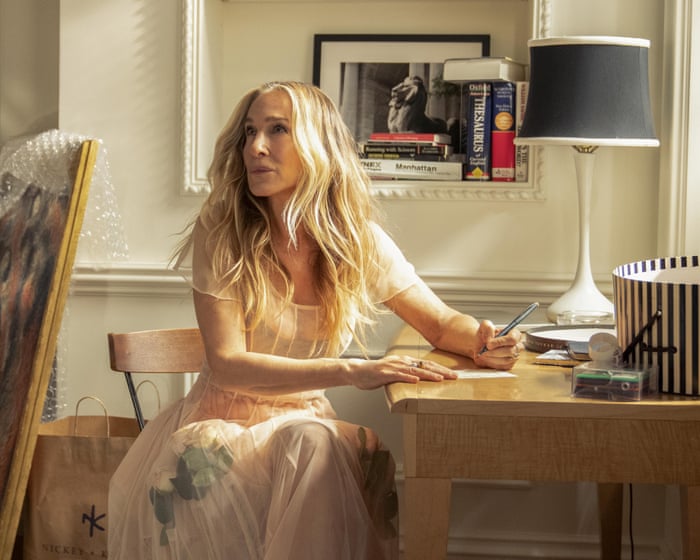And just like that, it was over. When showrunner Michael Patrick King announced on Friday that the third season of And Just Like That would be its last, the news was met with little surprise—and likely some relief. After an upcoming two-part finale, Carrie Bradshaw will retire her Manolos for good—and not a moment too soon.
If there’s one theme running through the messy third season of this Sex and the City reboot, it’s the tension between appearance and reality. Early on, Carrie—rattled by discovering rats in her picturesque garden—turns to Aidan for comfort. Though technically in a relationship with him, a convoluted and implausible arrangement keeps them apart for five years. “I thought my garden was perfect,” she says, “but I just wasn’t looking underneath.”
After three seasons, the answer to what lies beneath seems to be: nothing. Take the shoes. In a callback to one of the original show’s best episodes, Carrie references A Woman’s Right to Shoes while complaining about her grumpy downstairs neighbor asking her to take off her stilettos. In the original, her stolen Manolos symbolized the gaps between friends at different life stages, the unequal celebration of marriage versus independence, and a woman’s right to spend her money as she pleases. Here? They just mean she has a crush.
That’s not to say And Just Like That hasn’t had moments of insight—they’re just often abandoned for something sillier. This season, trimmed of unnecessary characters (Che Diaz) and bafflingly sidelined ones (Nya), gave the remaining cast more room to breathe. Seema learns that love isn’t about pretending to be someone else but letting go of how you want to be seen. Lisa struggles to balance work and family. Charlotte, previously distressed by trivial problems (like her dog’s canceled playdate), finally faces real drama when Harry is diagnosed with prostate cancer.
Charlotte and Lisa’s Park Avenue struggles with family life could have depth, but their interactions with their kids feel like they’re lifted from toothpaste commercials—or nightmares. Charlotte panics about missing high-society art sales while her smug kids lecture her on veganism and polyamory. The Wexleys’ cringey banter and Lisa’s dismissive Ozempic jokes about her husband don’t help.
At times, the show feels like a charmless sitcom about the ultra-rich. In Sex and the City, Hamptons weekends were just a backdrop for deeper stories. Here, the setting often is the story. One scene has Charlotte spiraling at Tiffany’s, pondering life’s fragility—until it devolves into a joke about Bitsy von Muffling’s party invites. Other moments border on cruelty, like when Lisa’s rival is mocked for carrying the wrong designer bag. After that, it’s hard to sympathize with her mother-in-law’s struggles.The claim that she has no time for the working class is clearly meant as satire. Meanwhile, Miranda—inexplicably homeless—has an affair with a nun, becomes an internet meme, and lands a girlfriend whose personality consists of owning two Italian greyhounds and tolerating obnoxious British coworkers who seem plucked straight from an over-the-top reality show. It isn’t until the 10th episode that Miranda finally does something reminiscent of her old self—the sharp-tongued queen from Sex and the City—when she stalks the woman her son got pregnant.
The season’s one bright spot has been its handling of Carrie’s crumbling relationship with Aidan. A standout episode finds her visiting him in Virginia, where a subdued Carrie, too afraid to ask for what she really wants, settles for the bare minimum—a spot in his guesthouse. She swaps her signature Vivienne Westwood for a frumpy “sister wives” dress, trying to play the role of a laid-back country stepmom. But the illusion of a happy blended family shatters in a rare well-executed domestic scene, where pent-up resentment erupts into a fight that ends with a broken window and a harsh return to reality.
Their relationship ultimately falls apart when Carrie realizes that no matter how much she changes for Aidan—selling her apartment, suppressing her city-girl tendencies (remember Suffern?)—he can’t move past her past betrayal. This, to me, is the real value of revisiting a story decades later: showing how people evolve—and how they don’t. Some wounds run too deep for time to heal; they just get buried. When Carrie finally ends things, I felt a genuine emotional tug—proof of how deeply invested we’ve become in these characters.
This season has leaned into the idea of “hate-watching,” especially with Miranda’s obsession with a Love Island-style show called Bi Bingo. “I finally discovered the joy of hate-watching,” she quips, a line that feels like the writers winking at their own critics.
But I don’t think that’s why longtime Sex and the City fans—who else would stick through three mediocre seasons of And Just Like That?—are still tuning in. It’s more like “hope-watching.” We wanted to see the characters we loved, once so vividly drawn, back in their element: flirty, frivolous, and impeccably dressed in New York. More than that, we hoped something meaningful still lingered beneath the glitter. With two episodes left, we’ll soon have our answer—and if we’re let down again, at least it’ll be for the last time.




